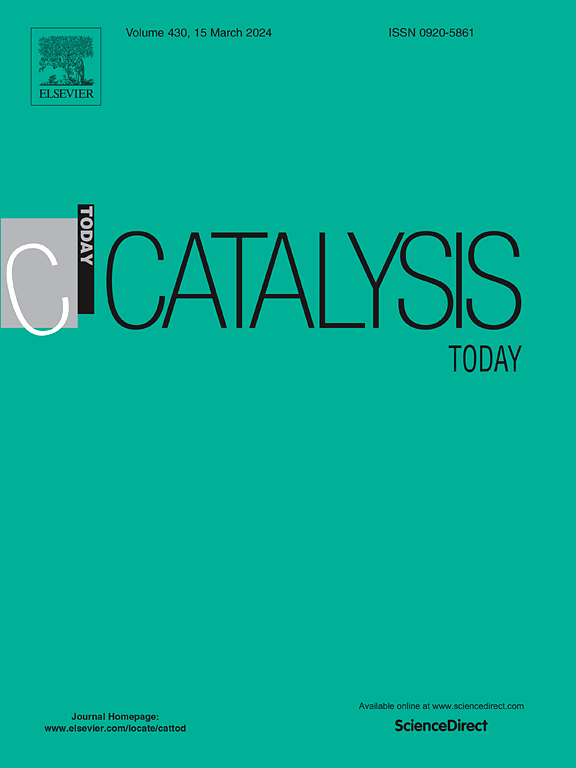Optimization of the production of bio-jet fuel precursors from acetoin and 2-methylfuran via hydroxyalkylation/alkylation over sulfonic acid resin
IF 5.2
2区 化学
Q1 CHEMISTRY, APPLIED
引用次数: 0
Abstract
Increasing carbon dioxide gas emissions in the aviation industry, together with the depletion of fossil fuel sources, are serious issues that require researchers to develop bio-jet fuel from sustainable renewable sources. A promising approach is the use of highly abundant and economic lignocellulosic waste biomass, from which furanic compounds can be derived. However, to obtain C9-C15 jet fuel-compatible products, C-C coupling strategies are mandatory to increase the chain length of the furanic platforms. Furthermore, there exists an uncovered potential for integrating fermentation-derived platforms, like acetoin, in advanced bio-jet fuel production routes. In this sense, this work explores the C-C coupling of acetoin, a fermentation-derived molecule, with 2-methylfuran (2-MF), a lignocellulose-derived molecule that can be obtained from selective hydrogenolysis of furfural, via hydroxyalkylation/alkylation (HAA). This solvent-free acid-catalyzed reaction yields oxygenated adducts incorporating one molecule of acetoin and 1-3 molecules of 2-MF (9–19 C atoms) that display high potential as bio-jet fuel precursors. However, side reactions are also present, coming from the auto-condensation of acetoin and/or 2-MF, yielding heavier or more oxygenated undesired compounds, so that selectivity appears as the key parameter in the catalyst performance. In this work, sulfonic acid-based resin Amberlyst-15 has displayed high activity and selectivity towards the most interesting di-condensed C14 compound, herein denoted as Ac(MF)2, which evidences the benefits of applying strong Brønsted acid sites allocated within a polymer matrix in high surface concentration. The optimization of the reaction conditions, assessed with the help of response surface methodology, led to over 77 % yield to Ac(MF)2 with acetoin conversion around 90 %, under the optimized reaction conditions (60 °C, 2-MF/acetoin = 2.5 (mol), 6 h, catalysts loading 20 wt% referred to acetoin). Amberlyst-15 catalyst was tested in a 5-cycle reusability experiment, keeping an acceptable level of catalytic activity and selectivity despite evidence of fouling due to the formation of organic deposits. These results pave the way for a new route of bio-jet fuel production starting from already established biomass-derived platform molecules.
丙酮和2-甲基呋喃羟烷基化/磺酸树脂烷基化法制备生物喷气燃料前驱体的优化研究
航空业二氧化碳排放量的增加,加上化石燃料的枯竭,是一个严重的问题,要求研究人员从可持续的可再生资源中开发生物喷气燃料。一种很有前途的方法是利用高度丰富和经济的木质纤维素废料生物质,从中可以提取呋喃化合物。然而,为了获得与C9-C15喷气燃料兼容的产品,必须采用C-C耦合策略来增加呋喃平台的链长。此外,在先进的生物喷气燃料生产路线中整合发酵衍生平台(如乙托因)存在未发现的潜力。从这个意义上说,这项工作探讨了乙托因(一种发酵衍生的分子)与2-甲基呋喃(2-MF)的C-C偶联,2-甲基呋喃(2-MF)是一种木质纤维素衍生的分子,可以通过羟基烷基化/烷基化(HAA)从糠醛的选择性氢解中获得。这种无溶剂酸催化反应产生含氧加合物,其中包含1分子乙酰和1-3分子2-MF(9-19 C原子),显示出作为生物喷气燃料前体的高潜力。然而,由于乙托因和/或2-MF的自动缩合,也会产生副反应,产生更重或含氧更多的不需要的化合物,因此选择性成为催化剂性能的关键参数。在这项研究中,以磺酸为基础的树脂Amberlyst-15对最感兴趣的二凝聚C14化合物Ac(MF)2表现出高活性和选择性,这证明了在高表面浓度的聚合物基质中分配强Brønsted酸位的好处。优化反应条件(60°C, 2-MF/acetoin = 2.5 (mol), 6 h,催化剂负载20 wt% (acetoin))下,Ac(MF)2的产率超过77 %,丙酮转化率约为90 %。Amberlyst-15催化剂在5个循环的重复使用实验中进行了测试,尽管有证据表明由于有机沉积物的形成而产生污染,但仍保持了可接受的催化活性和选择性水平。这些结果为从已经建立的生物质衍生平台分子开始的生物喷气燃料生产的新路线铺平了道路。
本文章由计算机程序翻译,如有差异,请以英文原文为准。
求助全文
约1分钟内获得全文
求助全文
来源期刊

Catalysis Today
化学-工程:化工
CiteScore
11.50
自引率
3.80%
发文量
573
审稿时长
2.9 months
期刊介绍:
Catalysis Today focuses on the rapid publication of original invited papers devoted to currently important topics in catalysis and related subjects. The journal only publishes special issues (Proposing a Catalysis Today Special Issue), each of which is supervised by Guest Editors who recruit individual papers and oversee the peer review process. Catalysis Today offers researchers in the field of catalysis in-depth overviews of topical issues.
Both fundamental and applied aspects of catalysis are covered. Subjects such as catalysis of immobilized organometallic and biocatalytic systems are welcome. Subjects related to catalysis such as experimental techniques, adsorption, process technology, synthesis, in situ characterization, computational, theoretical modeling, imaging and others are included if there is a clear relationship to catalysis.
 求助内容:
求助内容: 应助结果提醒方式:
应助结果提醒方式:


